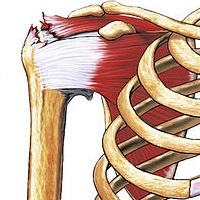
Photo from wikipedia
Background: Kinesiotaping is widely used for the rehabilitation of rotator cuff tendinopathy. It has been argued to reduce symptoms and functional limitations through improvement of proprioceptive feedback. In addition, kinesiotaping… Click to show full abstract
Background: Kinesiotaping is widely used for the rehabilitation of rotator cuff tendinopathy. It has been argued to reduce symptoms and functional limitations through improvement of proprioceptive feedback. In addition, kinesiotaping has been reported to increase the subacromial space in healthy subjects. However, its effects on the acromiohumeral distance and shoulder proprioception of individuals with rotator cuff tendinopathy have not been ascertained. This study investigated the immediate effects of kinesiotaping on the acromiohumeral distance and shoulder proprioception in individuals with rotator cuff tendinopathy. Methods: Twenty‐two individuals with chronic rotator cuff tendinopathy were included. The acromiohumeral distance was measured using an ultrasound scanner at rest and 60° shoulder abduction. Proprioception was measured through active joint repositioning in low‐ (45°–65°) and mid‐amplitude (80°–100°) of shoulder flexion and abduction. A wireless inertial measurement unit system was used to quantify shoulder angles. First, measurements were taken without kinesiotaping. Thereafter, kinesiotaping was applied on the symptomatic shoulder, and the same measurements were retaken. Repeated measures ANOVAs were used for statistical analyses. Findings: Kinesiotaping induced a significant increase in acromiohumeral distance at 60° abduction (&Dgr;AHD = 0.94 mm; 95%CI: 0.50–1.38, p < 0.001), exceeding the minimal detectable change (0.70 mm). No significant difference was observed in acromiohumeral distance at rest or in proprioception during active joint repositioning in both low‐ and mid‐amplitude (p > 0.05). Interpretation: Kinesiotaping led to an immediate increase in acromiohumeral distance at 60° of abduction that, although it seems a minor change (↑10.5%), it may be significant for symptomatic patients, whereas it had no immediate effect on active joint repositioning. HighlightsKinesiotaping increased the acromiohumeral distance at 60° of shoulder abduction.The kinesiotaping effects exceeded the minimal detectable change at 60° abduction.Kinesiotaping did not provide changes in the shoulder proprioception.
Journal Title: Clinical Biomechanics
Year Published: 2019
Link to full text (if available)
Share on Social Media: Sign Up to like & get
recommendations!